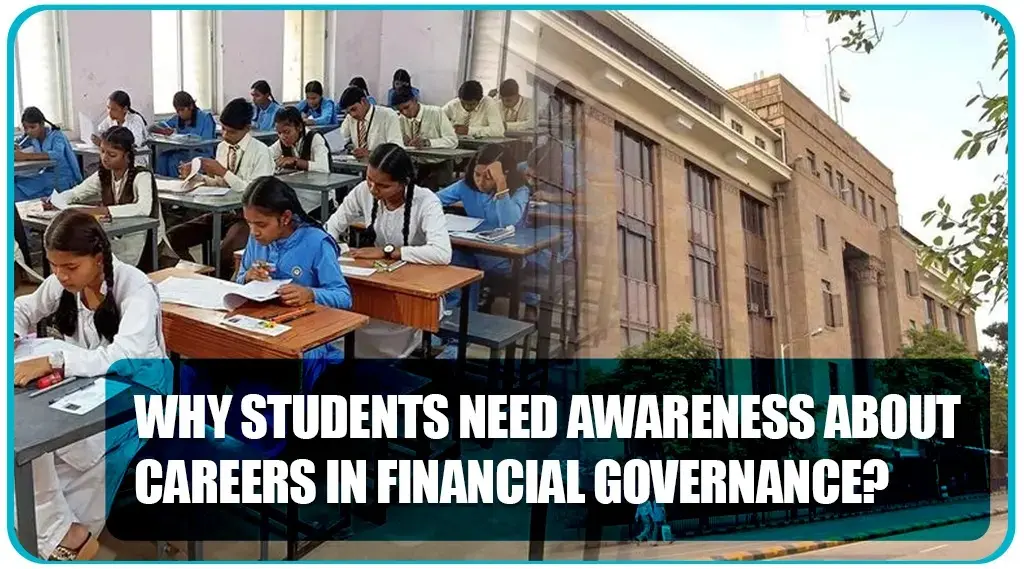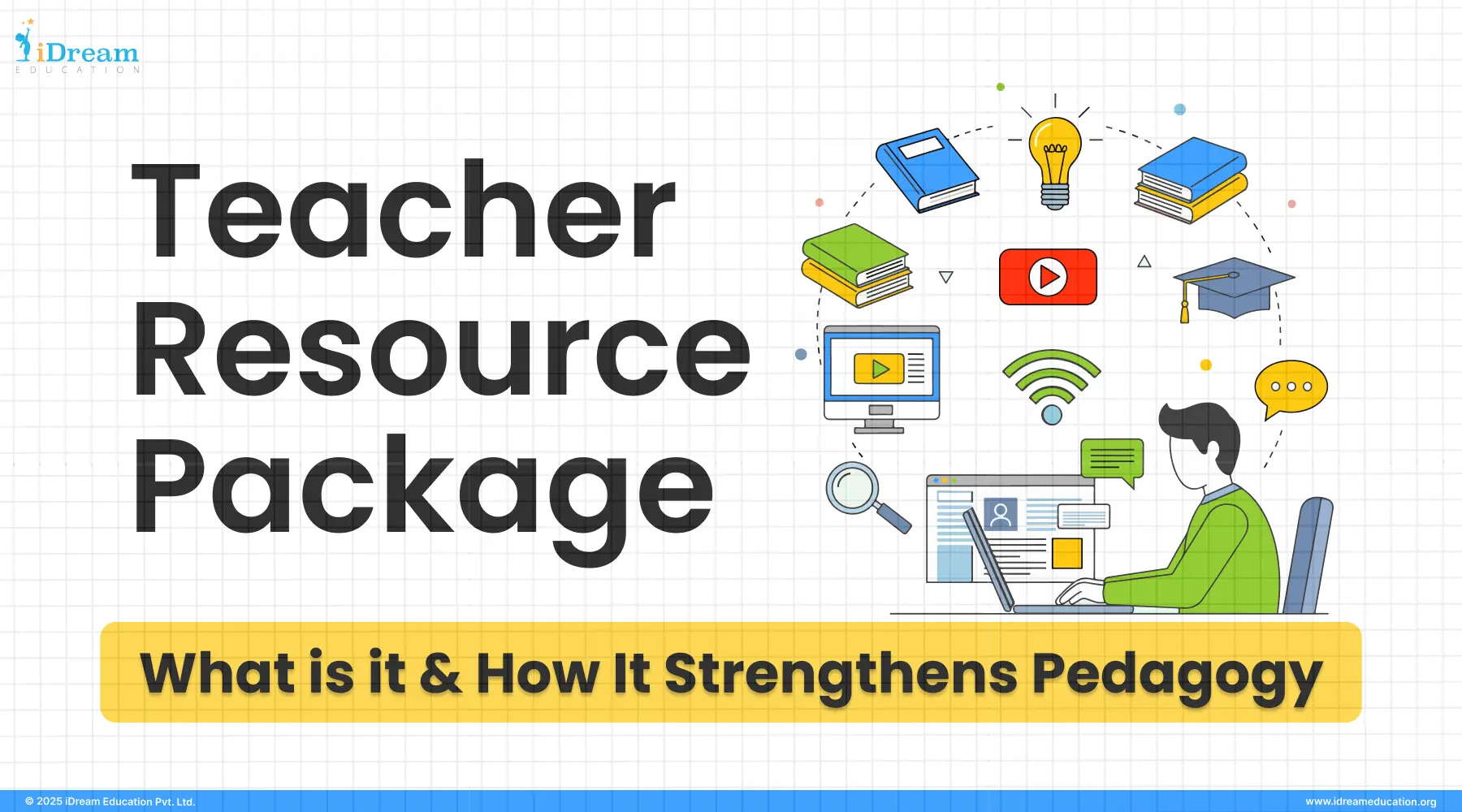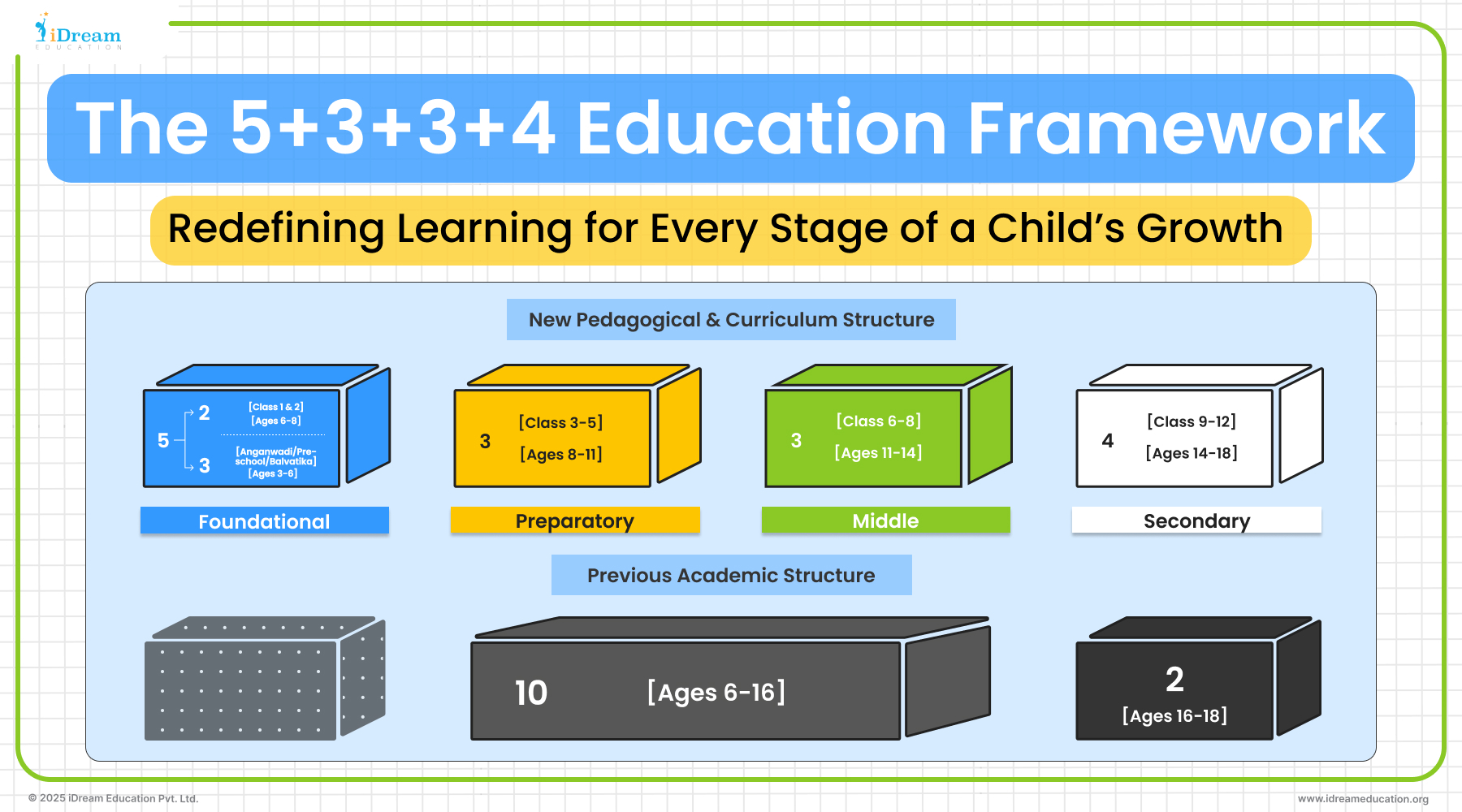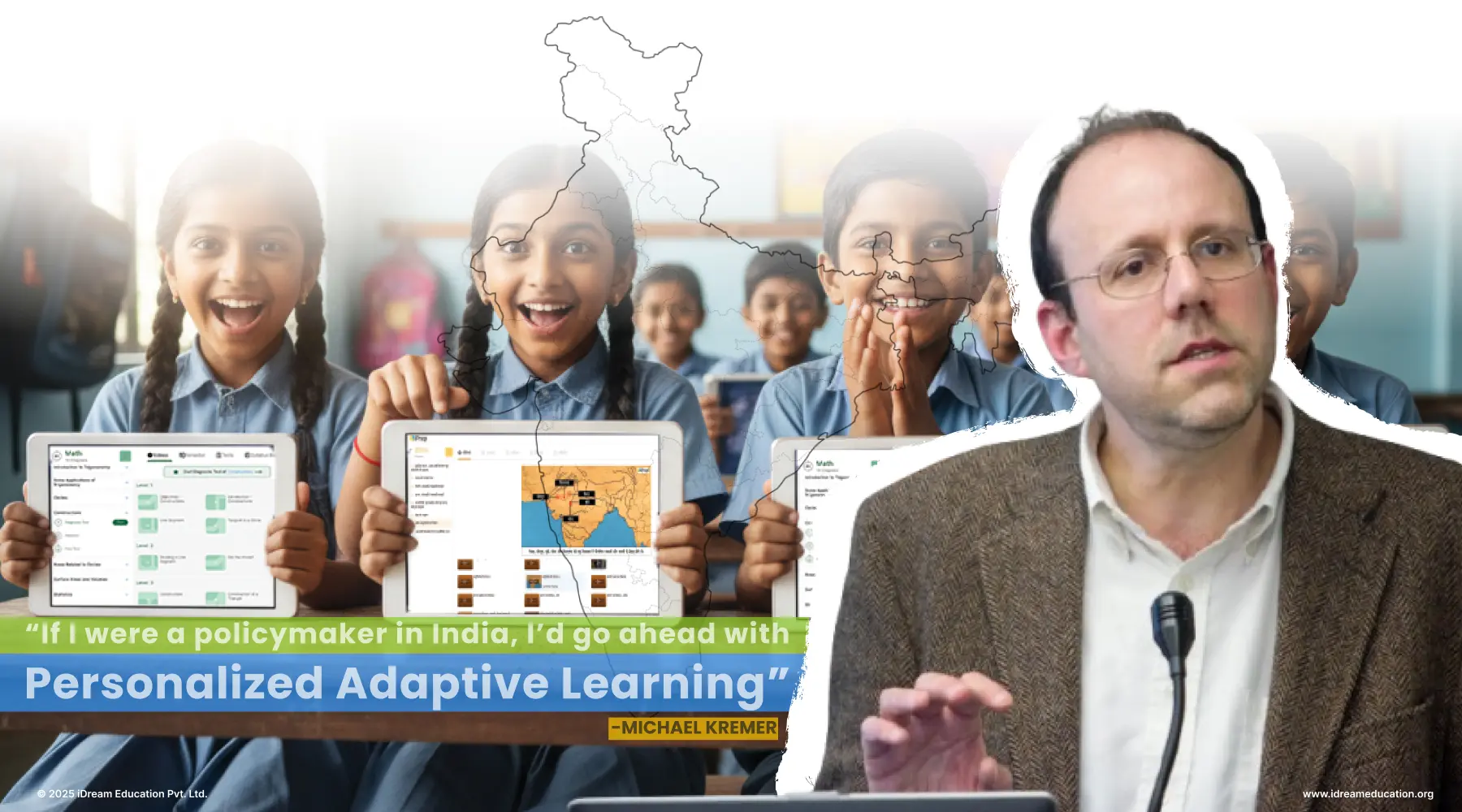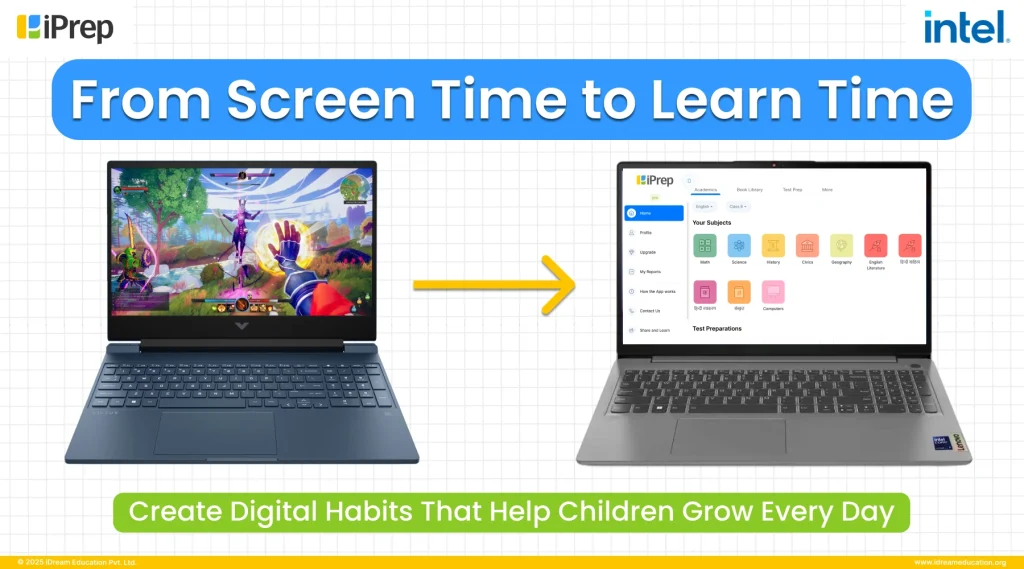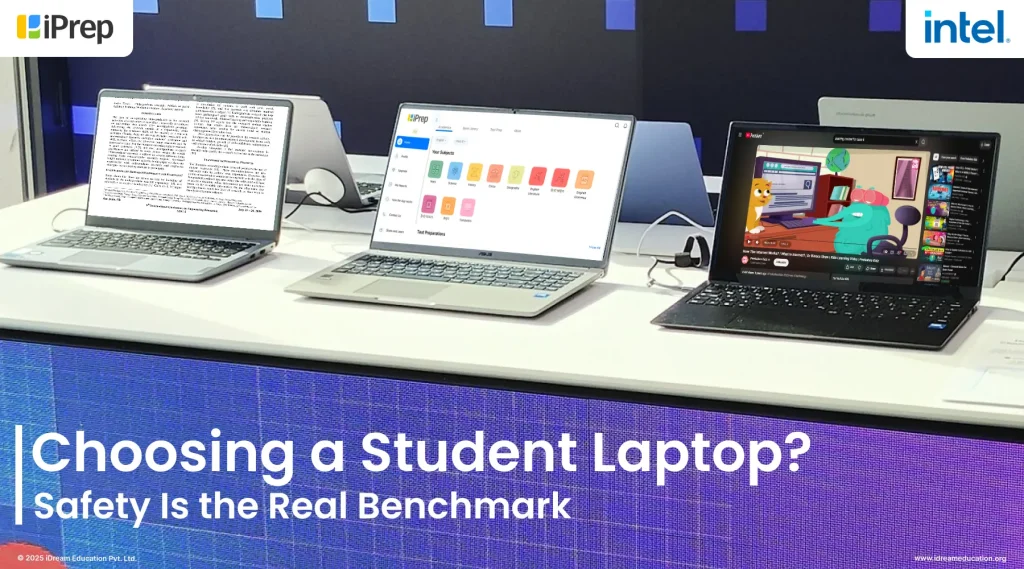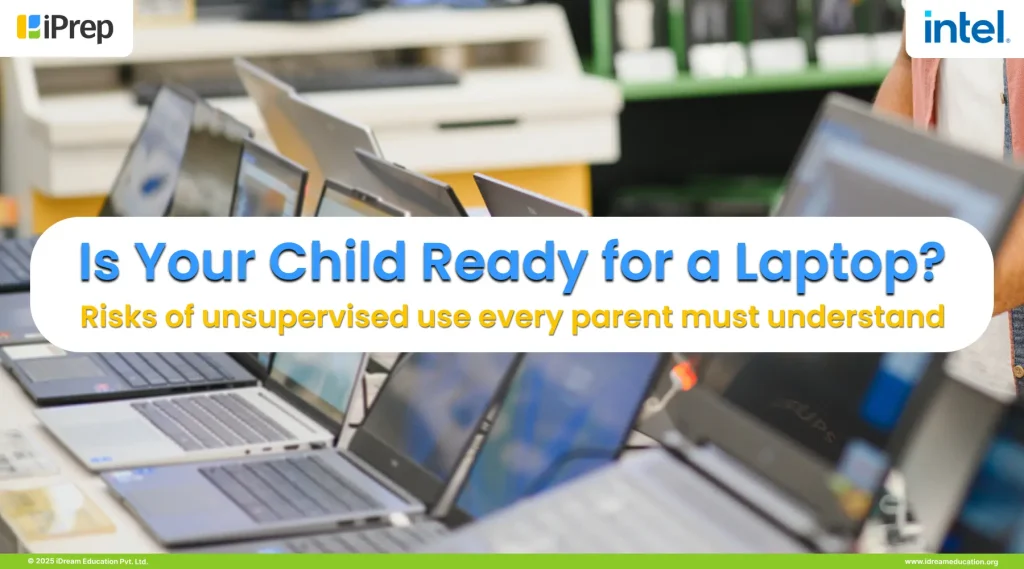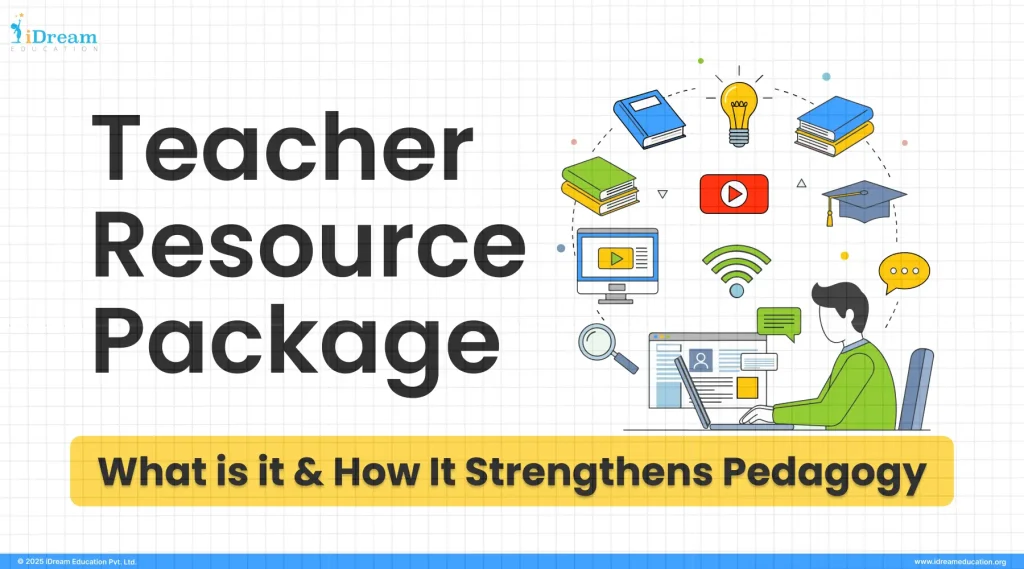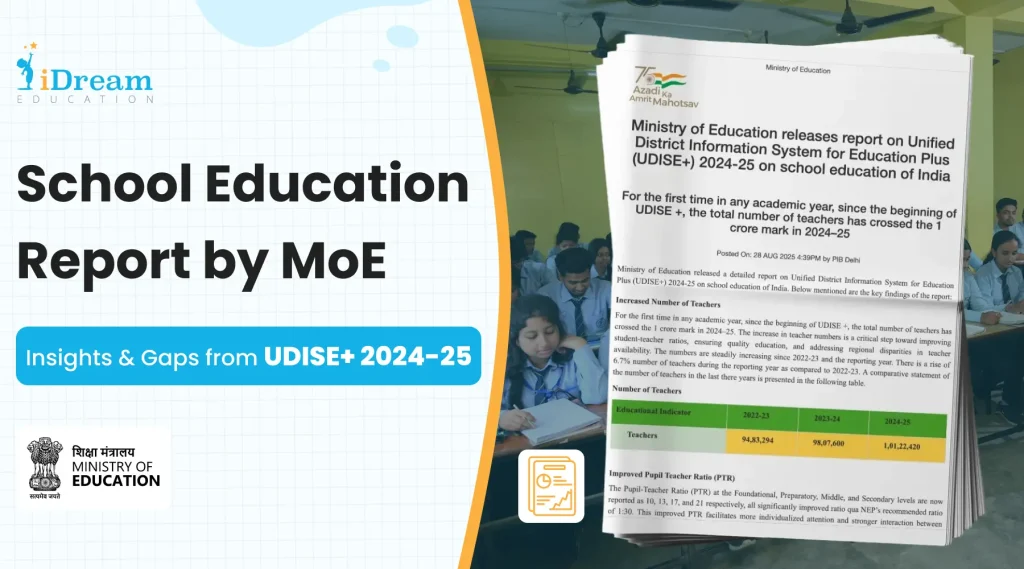
The future of India’s schools is often best understood through data, and the Unified District Information System for Education Plus (UDISE+) is one of the most credible sources we have. Managed by the Department of School Education & Literacy under the Ministry of Education, this educational management information system offers an annual snapshot of how our schools are performing. It not only highlights numbers, but shows real indicators of access, equity, and quality.
On 28th August 2025, the Ministry of Education released the UDISE+ 2024-25 report on school education in India.
The findings are both encouraging and insightful, reflecting how far the system has progressed in terms of teacher strength, student retention, digital access, and school infrastructure. From crossing the 1 crore teacher milestone to witnessing a steady decline in dropout rates and an increase in internet-enabled schools, the report captures a story of resilience and transformation.
Let’s look at key highlights of the UDISE+ 2024-25 report by MoE
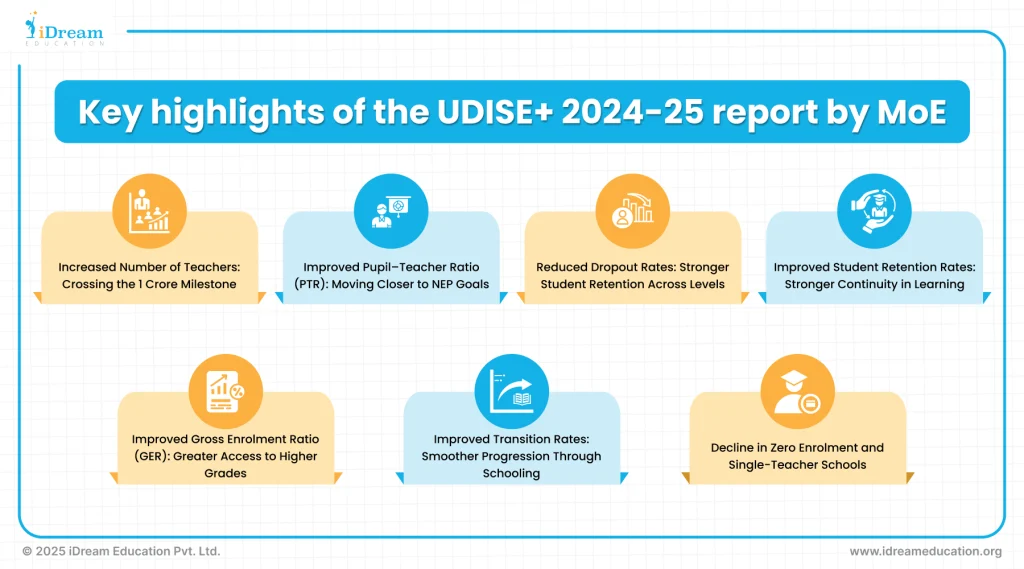
Increased Number of Teachers
- One of the most remarkable highlights of the UDISE+ 2024-25 report is the significant rise in the number of teachers across India. For the first time since the inception of UDISE+, the total count of teachers in schools has crossed the 1 crore mark, reaching 1,01,22,420 in 2024-25. This marks a 6.7% increase compared to 2022-23, when the figure stood at 94,83,294, and a notable jump from 98,07,600 teachers in 2023-24.
- This steady growth represents a vital step toward strengthening the student–teacher ratio. This shows that now classrooms are not overcrowded and every child is receiving the attention they deserve.
Improved Pupil–Teacher Ratio (PTR)
- Another encouraging outcome highlighted in the UDISE+ 2024-25 report is the steady improvement in the Pupil–Teacher Ratio (PTR) across all school levels. The PTR in no. for the year 2024-25 stands at: Foundational: 10, Preparatory: 13, Middle: 17, Secondary: 21. This marks a clear progress when compared to previous years. In 2023-24, the PTR was 10 (Foundational), 13 (Preparatory), 18 (Middle), and 21 (Secondary). Going further back, in 2022-23, it stood at 11, 14, 18, and 23 respectively.
- What makes this development significant is that the ratio aligns with NEP 2020 recommended benchmark of 1:30, which means Indian classrooms are becoming less crowded and more conducive to personalized attention. A better PTR allows teachers to engage more effectively with students, understand their unique learning needs, and support them in achieving stronger academic outcomes.
- This shift indicates not just an increase in teacher numbers but also a tangible improvement in the quality of classroom interactions. This improvement is making the way for a more inclusive and learner-centric education system.
Reduced Dropout Rates
A particularly heartening trend in the UDISE+ 2024-25 report is the decline in dropout rates across the Preparatory, Middle, and Secondary stages. Compared to the previous years, the improvement is significant:
- Preparatory stage: dropped from 3.7% (2022-23) to 3.1% (2023-24) and further down to 2.3% (2024-25)
- Middle stage: reduced from 5.2% (2022-23) to 4.3% (2023-24) and then to 3.5% (2024-25)
- Secondary stage: declined from 10.9% (2022-23) to 9.6% (2023-24) and further to 8.2% (2024-25)
This consistent downward trend is a strong indicator of improved student retention However, while the progress is significant, it remains gradual. The major challenge lies in incremental learning. Many students continue to struggle with historical learning gaps that limit their ability to keep pace with grade-level expectations. Unless these gaps are addressed, dropout rates may continue to decline only marginally rather than drastically. To tackle this, Personalized Adaptive Learning (PAL) solutions are being designed and deployed on student devices, enabling learners to bridge gaps and achieve grade-level proficiency. Such innovations, combined with social sector and government initiatives, show promise, but their reach needs to be multiplied and scaled if we are to ensure that every child not only stays in school but thrives in their learning journey.
Improved Student Retention Rates
The UDISE+ 2024-25 report showcases a significant rise in student retention rates across all stages of school education, signaling that more learners are not only enrolling but also continuing their studies. The latest figures reveal encouraging growth compared to the previous year:
- Foundational level: increased from 98.0% (2023-24) to 98.9% (2024-25)
- Preparatory level: from 85.4% to 92.4%
- Middle level: from 78.0% to 82.8%
- Secondary level: from 45.6% to 47.2%
While this upward trend is encouraging, the growth is incremental and slower than what is truly needed. A retention rate of 47.2% at the secondary level, for instance, is far from where it should be ideally closer to 90–100%. These figures remind us that ensuring students remain in school is not enough; they must also be learning meaningfully, understanding concepts, and finding joy in the process.
To further accelerate retention, students need curriculum-aligned, multimodal content that not only supports their textbooks but also sparks curiosity and sustained engagement. When content is designed to match 21st-century learning needs that is interactive, adaptive, and relevant, it builds continuity in learning. At scale, such intervention can drive a substantial jump in retention percentages by 2026 and beyond.
Improved Gross Enrolment Ratio (GER)
The UDISE+ 2024-25 report also records a steady rise in the Gross Enrolment Ratio (GER), particularly at the Middle and Secondary levels, highlighting progress in making education more inclusive and accessible.
- Middle level GER: increased from 89.5% (2023-24) to 90.3% (2024-25)
- Secondary level GER: improved from 66.5% to 68.5% in the same period
While this upward trend is encouraging, the pace of improvement is still gradual, and the gaps remain significant. This is especially at the Secondary level, where nearly one in three children are still not enrolled. This highlights the urgent need to go beyond access and address the barriers that keep students out of classrooms such as economic constraints, lack of engaging learning environments, and historical learning gaps.
To bridge this gap, it is critical to focus on holistic interventions: strengthening infrastructure, ensuring equitable digital access, and integrating adaptive learning environment. This has the potential to motivate learners to stay and progress to higher grades. Only then can GER rise substantially and reflect not just enrollment, but meaningful participation and continuity in learning.
Improved Transition Rates
The UDISE+ 2024-25 report shows a positive shift in transition rates, meaning more students are successfully moving from one stage of schooling to the next without dropping out. The latest data highlights steady improvement across all key transition points:
- Foundational → Preparatory: increased from 98.1% to 98.6%
- Preparatory → Middle: rose from 88.8% to 92.2%
- Middle → Secondary: improved from 83.3% to 86.6%
These upward movements demonstrate that the school system is becoming more effective at retaining students as they progress through different stages. However, a closer look reveals persistent gaps. While early transitions are nearing universal levels, the sharp dip is evident as students move into Secondary schooling, where transition rates are still significantly lower than they should be. This indicates that structural barriers, weak foundational learning, and lack of engaging academic support could be potential reasons limiting smoother progression for many learners.
To address this, the focus should be on bridging learning gaps early, in alignment with the spirit of the revocation of No Detention Policy. After the revocation, students are not simply promoted to the next grade, but are critically supported and assessed to ensure they build the confidence and competence to meet grade-level expectations.
Decline in Zero Enrolment and Single-Teacher Schools
Another notable achievement highlighted in the UDISE+ 2024-25 report is the reduction in zero-enrolment schools and single-teacher schools. Both of these have been long pending challenges in India’s schooling system.
- The number of single-teacher schools reduced by about 6% compared to the previous year.
- The count of zero-enrolment schools witnessed a sharp drop of nearly 38%.
This is a highly encouraging trend. However, a deeper look reveals that while the numbers are falling, the challenge is not yet resolved. A large proportion of single-teacher schools still remain. Similarly, the drop in zero-enrolment schools often comes from closures of schools rather than genuine improvements in enrolment.
To truly address these gaps, the focus must be on: Strengthening teacher availability, improving education accessibility and ensuring quality learning. Beyond enrollment and staffing, investing in teacher capacity building, enhancing the learning environment, and setting up solutions students look for can improve the situation in schools. Only then will the reduction in zero-enrolment and single-teacher schools translate into equitable access and meaningful learning outcomes, rather than just statistical progress.
Now, Let’s Look at Infrastructure Improvements in UDISE+ 2024-25 — Driving the Gains We’ve Seen Above
More Schools with Computer Access
- The UDISE+ 2024-25 report highlights significant progress in the digital infrastructure of schools, a critical factor in modern education. The number of schools with computer access has increased from 57.2% in 2023–24 to 64.7% in 2024–25.
- While this growth is encouraging, it still represents limited integration when viewed against today’s context, the aspirations of NEP 2020, the ICT Scheme under Samagra Shiksha, and the Viksit Bharat 2047 vision, all of which emphasize 100% technology integration in schools. The question then arises: what is slowing down adoption? Is it the perception of heavy investment, challenges in usage, or the complexities of setup and maintenance? In reality, the ICT scheme has already simplified integration through single-unit smart classes and tablet/notebook-based ICT labs that are easy to set up, manage, and use. Yet, the pace of evaluation and adoption remains slow, limiting the reach and impact of these solutions. If we are to prepare schools and learners for a digital-first future, accelerating technology integration must become a priority, ensuring that every school has the tools to deliver inclusive, engaging, and future-ready learning.
More Schools with Internet Access
- The UDISE+ 2024-25 report shows a substantial rise in the number of schools with internet connectivity, increasing from 53.9% in 2023–24 to 63.5% in 2024–25. This improvement reflects a strong focus on strengthening digital infrastructure, allowing schools to provide students and teachers with access to online resources, digital content, and technology-enabled teaching methods.
- With better internet access, classrooms are becoming more interactive and resource-rich. However, unfiltered internet exposure in schools also comes with risks of distractions, unsafe content, and the challenge of keeping learners focused on constructive use. To balance these opportunities and challenges, schools should adopt a cautious, structured approach, prioritizing safe and curriculum-aligned offline digital learning solutions that work seamlessly with limited or no internet.
Improvement Basic Infrastructure of Schools
The UDISE+ 2024-25 report highlights significant progress in basic school infrastructure. Key improvements include:
- Electricity: 93.6% of schools are now powered
- Girls’ toilets: 97.3%
- Boys’ toilets: 96.2%
- Handwashing facilities: 95.9%
- Safe drinking water: 99.3%
These upgrades are more than just statistics, they ensure dignity, hygiene, and safety for all students, which is important and led to increased retention, enrolment, and transition rates. Improved facilities also contributed directly to better learning outcomes and overall progress highlighted throughout the UDISE+ 2024-25 findings.
Improved Female Representation in Schools
The UDISE+ 2024-25 report also highlights encouraging progress in female representation within the education system, both among teachers and students.
- Female teachers: Female teachers in 2024-25 make up 54.2% of the total teaching workforce, up from 53.3% in 2023–24 and 52.3% in 2022–23, reflecting a positive shift toward gender balance in schools.
- Girls’ enrolment: has risen slightly from 48.1% to 48.3%, showing continued efforts to improve access and participation for girls across all levels of schooling.
This dual improvement, in both female teaching staff and girl student enrolment, signals a broader commitment to gender equity, helping ensure that schools are safe, welcoming, and empowering spaces for all learners.
Being a part of the education ecosystem – working closely with CSR partners, government bodies, NGOs, hardware providers, and other education allies, we feel truly encouraged to see the improvements reflected in the UDISE+ 2024–25 report. But these insights are more than just numbers; they raise an important question: should we celebrate the progress so far, or hold ourselves accountable to ensure it translates into deeper, more meaningful change?
- While enrolments, retention, and infrastructure are improving, the report still leaves a critical gap – learning outcomes and student proficiency levels remain underrepresented. This must become the central focus if we are to achieve real impact. One example is the growing emphasis on Personalized Adaptive Learning (PAL) on student devices, where every learner’s progress can be tracked dynamically. From diagnostic assessments to final outcomes, while offering remedial support PAL helps students bridge gaps and achieve grade-level proficiency. PAL is highlighted in World Bank’s Best Buys for Education Reports — 2020 and 2023
Another important point to note is that infrastructure improvements are directly proportional to better learning outcomes.
Stronger facilities in schools naturally lead to reduced dropout rates, improved student retention, higher Gross Enrolment Ratios (GER), and smoother transition rates across levels. The insights from UDISE+ 2024-25 reinforce that strengthening school infrastructure is not just about physical assets but about enabling an environment where learning thrives. However, the real impact comes when these improvements are combined with strategic interventions that holistically target teachers, students, learning gaps, and infrastructure together.
A similar correlation can be clearly seen in our work in Meghalaya
When we started in 2022, there was limited awareness about the importance of education, no exposure to technology, and the Class 10 pass percentage was just 25%. This not only led to less engagement but also led to higher dropouts and fewer students continuing into higher grades. However, with two years of focused interventions—smart class implementation, technology-enabled assessments, and bridging support for learners, the results have been transformational. The pass percentage has risen to 92% in just two years, enrolments have gone up, and the government is now more invested in long-term educational goals.
These changes reinforce the message of UDISE+ 2024–25: when we collectively invest in better infrastructure and equitable access, schools become places of unlimited learning and growth. The progress we are seeing today is just the beginning of a brighter educational journey for India.
If you are seeking a comprehensive solution provider that can transform schools – from digitizing infrastructure to improving pass percentages, retention, enrolments, transition rates, and teacher capacity. You can connect with us at +91 7678265039 or share your details here. You can also write to us at share@idreameducation.org


